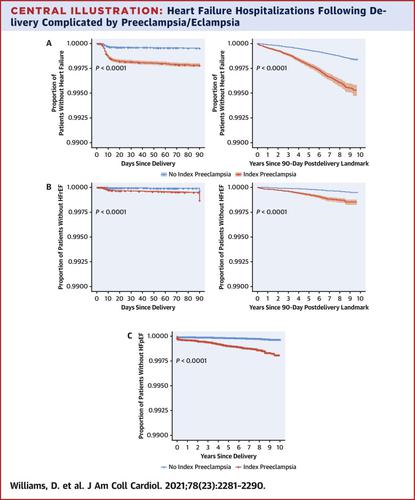Journal of the American College of Cardiology ( IF 21.7 ) Pub Date : 2021-11-29 , DOI: 10.1016/j.jacc.2021.09.1360 Dominique Williams 1 , Molly J Stout 2 , Joshua I Rosenbloom 3 , Margaret A Olsen 4 , Karen E Joynt Maddox 1 , Elena Deych 1 , Victor G Davila-Roman 1 , Kathryn J Lindley 5

|
Background
Preeclampsia is associated with increased risk of future heart failure (HF), but the relationship between preeclampsia and HF subtypes are not well-established.
Objectives
The objective of this analysis was to identify the risk of HF with preserved ejection fraction (HFpEF) following a delivery complicated by preeclampsia/eclampsia.
Methods
A retrospective cohort study using the New York and Florida state Healthcare Cost and Utilization Project State Inpatient Databases identified delivery hospitalizations between 2006 and 2014 for women with and without preeclampsia/eclampsia. The authors identified women admitted for HF after discharge from index delivery hospitalization until September 30, 2015, using International Classification of Diseases-9th Revision-Clinical Modification diagnosis codes. Patients were followed from discharge to the first instance of primary outcome (HFpEF hospitalization), death, or end of study period. Secondary outcomes included hospitalization for any HF and HF with reduced ejection fraction, separately. The association between preeclampsia/eclampsia and HFpEF was analyzed using Cox proportional hazards models.
Results
There were 2,532,515 women included in the study: 2,404,486 without and 128,029 with preeclampsia/eclampsia. HFpEF hospitalization was significantly more likely among women with preeclampsia/eclampsia, after adjusting for baseline hypertension and other covariates (aHR: 2.09; 95% CI: 1.80-2.44). Median time to onset of HFpEF was 32.2 months (interquartile range: 0.3-65.0 months), and median age at HFpEF onset was 34.0 years (interquartile range: 29.0-39.0 years). Both traditional (hypertension, diabetes mellitus) and sociodemographic (Black race, rurality, low income) risk factors were also associated with HFpEF and secondary outcomes.
Conclusions
Preeclampsia/eclampsia is an independent risk factor for future hospitalizations for HFpEF.
中文翻译:

先兆子痫预测保留射血分数的心力衰竭住院风险
背景
先兆子痫与未来心力衰竭 (HF) 的风险增加有关,但先兆子痫与 HF 亚型之间的关系尚不明确。
目标
该分析的目的是确定在合并先兆子痫/子痫的分娩后发生射血分数保留 (HFpEF) 的 HF 风险。
方法
一项使用纽约州和佛罗里达州医疗保健成本和利用项目州住院患者数据库的回顾性队列研究确定了 2006 年至 2014 年间患有和未患有先兆子痫/子痫的妇女的分娩住院情况。作者使用国际疾病分类-第 9 次修订-临床修改诊断代码确定了在指数分娩住院出院后至 2015 年 9 月 30 日之前因 HF 入院的女性。患者从出院到第一次出现主要结局(HFpEF 住院)、死亡或研究结束。次要结局包括因任何心力衰竭住院和射血分数降低的心力衰竭。使用 Cox 比例风险模型分析先兆子痫/子痫和 HFpEF 之间的关联。
结果
研究中包括 2,532,515 名女性:2,404,486 名未患有先兆子痫/子痫,128,029 名患有先兆子痫/子痫。在调整基线高血压和其他协变量后,患有先兆子痫/子痫的女性更可能因 HFpEF 住院(aHR:2.09;95% CI:1.80-2.44)。HFpEF 发病的中位时间为 32.2 个月(四分位距:0.3-65.0 个月),HFpEF 发病的中位年龄为 34.0 岁(四分位距:29.0-39.0 岁)。传统(高血压、糖尿病)和社会人口学(黑人种族、农村、低收入)风险因素也与 HFpEF 和次要结果相关。
结论
先兆子痫/子痫是未来因 HFpEF 住院的独立危险因素。











































 京公网安备 11010802027423号
京公网安备 11010802027423号